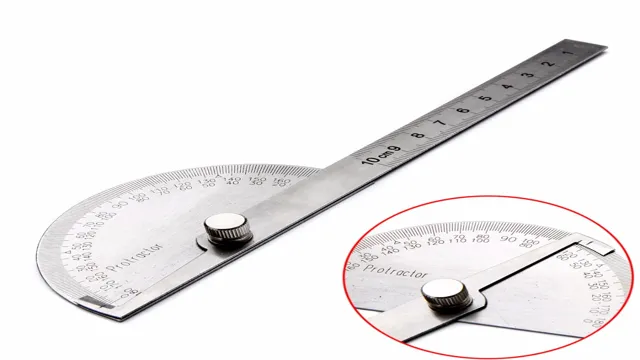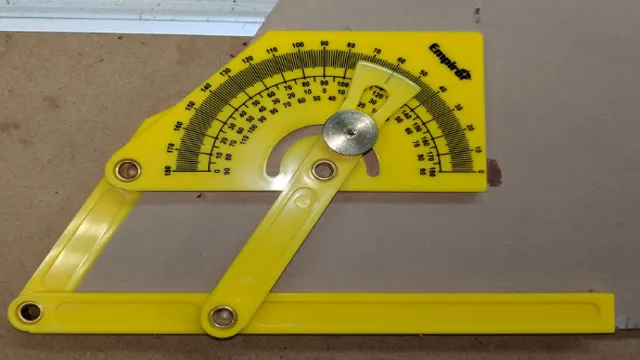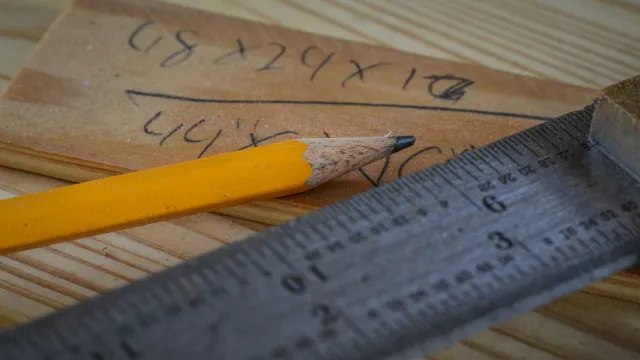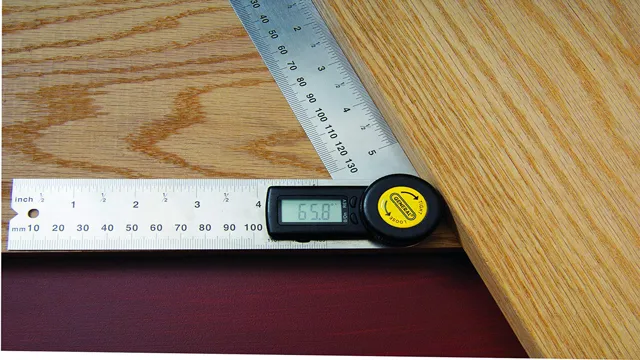How Does a Digital Angle Finder Work? A Comprehensive Guide to Using This Useful Tool!
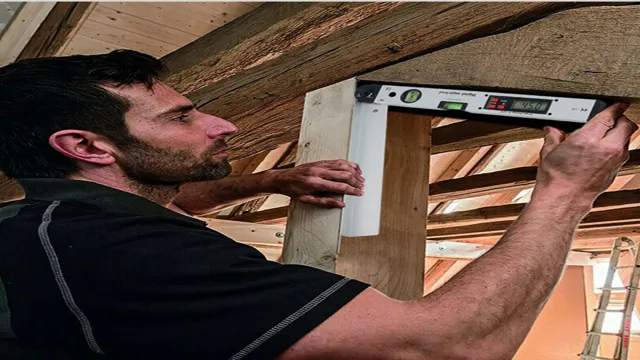
If you are an avid DIY-er or a professional contractor, you might have stumbled upon a digital angle finder while working on a project. This tool, also known as a digital protractor or inclinometer, is essential for measuring angles accurately. But have you ever wondered how does a digital angle finder work? Well, the answer is quite simple.
A digital angle finder works by using an electronic sensor that detects the angle between two surfaces. This sensor is attached to a hinge or a pivot point, which allows it to move and adjust to different angles. The angle is then displayed on a digital screen, making it easy for you to read and measure the angle.
Think of a digital angle finder as a digital version of the traditional protractor. Instead of having to manually align the protractor to the angle, the digital angle finder automatically detects it. This feature makes it much more efficient and accurate.
Moreover, digital angle finders come with additional features such as a hold function, which allows you to lock the angle measurement for easy reading. Some models also include a level vial that allows you to check for level and vertical angles. In conclusion, digital angle finders are a great tool for anyone who works with angles.
They are accurate, efficient, and easy to use. Now that you know how it works, you can use this tool confidently to ensure your projects come out perfectly every time.
What is a Digital Angle Finder?
Learning how a digital angle finder works is essential for those who want precise and accurate measurements. A digital angle finder is a tool used to measure angles with accuracy, and it uses digital technology to achieve this. Unlike traditional angle finders that use a manual dial to determine angles, digital angle finders use an electronic sensor to measure the angle.
This sensor records the tilt and rotation of the tool and then sends this information to a digital display where it is shown as a numerical value. Digital angle finders are ideal for carpenters, builders, and mechanics who need to determine accurate angles for their work. With a simple calibration, the tool is ready to use, and it provides reliable results every time.
Whether it’s determining the angle of a staircase railing or measuring the roof pitch, a digital angle finder is an essential tool for anyone who needs precise angle measurements.
Definition and Explanation
A digital angle finder is a tool used to measure the angles between two intersecting lines or surfaces. It features an electronic display that indicates the angle, and an adjustable arm that can be locked in place to maintain the measurement. This tool is invaluable for anyone in fields such as carpentry, construction, metalwork, and engineering, where precise measurements are essential for success.
Its accuracy is much higher than traditional protractors, which makes it a popular choice among professionals who require exact measurements. With its convenience and ease of use, the digital angle finder has become a staple in any toolbox. It saves time, minimizes errors, and improves overall efficiency, making it a worthy investment for any handyman or DIY enthusiast.
So, if you want to make sure your work is accurate and precise, a digital angle finder is an indispensable tool that you shouldn’t be without.
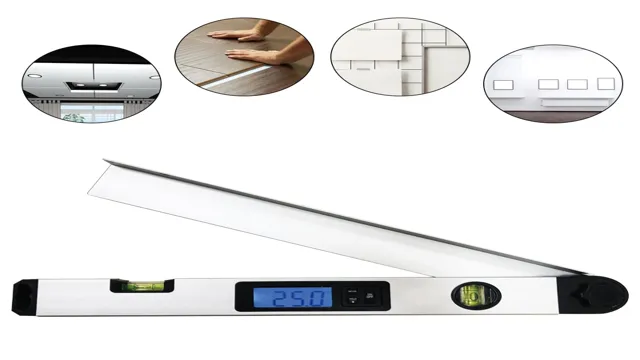
Types of Digital Angle Finders
A digital angle finder is an essential tool for carpenters, woodworkers, and DIY enthusiasts who need to make precise measurements and cuts. It is a device that can accurately measure angles and display the results on a digital screen. There are different types of digital angle finders, each designed to serve specific purposes.
Overall, the use of a digital angle finder saves time and effort, and it guarantees accuracy in measurements. One example of a digital angle finder is a protractor-type device that has a mechanical arm that swings open and closed, taking measurements from both sides. Another type is a blade-type device that has a blade that slides back and forth, taking measurements at different angles.
Additionally, some angle finders are designed as an attachment to power tools like saws, drills, and routers, making it convenient to use in making precise cuts. Ultimately, digital angle finders are an essential tool for anyone working on woodworking projects, and their use ensures the accuracy of measurements and precision in cuts.
Working of a Digital Angle Finder
If you’re wondering how a digital angle finder works, it’s actually quite simple. These handy little tools use a combination of sensors and microprocessors to accurately measure the angle between two surfaces. When you place the device against a surface, it uses its built-in sensor to detect the angle between that surface and the horizontal plane.
This information is then processed by the microprocessor and displayed on a digital screen. Some digital angle finders also come equipped with additional features such as a bubble level or a laser guide, which can help make measurements even more accurate. Whether you’re a professional contractor or a DIY enthusiast, a digital angle finder can save you time and help you work more accurately.
So if you’re in the market for one, be sure to look for a model that has the features you need and a reputation for accuracy.
Sensors and Microprocessors
A digital angle finder is a handy tool that is used to measure angles with precision. This tool works by combining the power of sensors and microprocessors. The sensors in the tool detect the angle at which it is held, and the microprocessors convert this angle into a digital value that can be read by the user.
The working of the digital angle finder is quite simple, as it relies on the basic principles of trigonometry. The tool has two arms that can be rotated to measure angles between them. The sensors in the tool detect the angle between the two arms and send this information to the microprocessors.
The microprocessors then calculate the angle and display it on the screen. This tool is widely used in construction, woodworking, metalworking, and other fields where precise angle measurements are required. With its accuracy and ease of use, a digital angle finder is a versatile tool that can help users save time and increase efficiency in their work.
Displays and Readouts
A digital angle finder is a tool commonly used by woodworkers, construction workers, and other professionals who need to measure angles accurately. It works by using a set of sensors inside the tool to measure the angle between two surfaces. The data is then displayed on a digital readout, which makes it easy to read and interpret.
Some angle finders also come with a built-in level, which makes it easy to ensure that your work surface is level before measuring the angle. The best part is that digital angle finders are incredibly easy to use, making them a favorite among professionals and beginners alike. With just a few clicks of a button, you can switch between different units of measurement and get accurate readings in no time.
So if you’re looking for a reliable tool to help you measure angles with precision, consider investing in a digital angle finder today!
Advantages of Digital Angle Finder
Digital angle finders are incredibly handy tools that enable you to measure angles with high precision. But how does a digital angle finder work? Well, these devices use electronic sensors, which are capable of sensing the angle between two lines accurately. These sensors are equipped with a microprocessor that converts the angle measurement into an electronic signal, which is then displayed on an LCD screen.
Unlike traditional angle finders, digital options provide you with precise measurements of angles within a matter of seconds, without requiring you to do any manual calculations. Moreover, some digital angle finders come with additional features, such as a hold function that enables you to lock the measurement and keep it on the screen. This is especially useful if you need to take measurements in an awkward or hard-to-reach location.
Overall, using a digital angle finder will make any measuring task easier, faster, and more accurate.
Accuracy and Precision
The accuracy and precision of a measurement are crucial to any project, and a digital angle finder certainly hits the mark. One of the standout advantages of a digital angle finder is its ability to provide highly accurate readings, often in fractions of a degree. Additionally, many digital angle finders allow for easy conversion between different units of measurement, saving time and reducing error.
Another benefit is that digital angle finders typically have clear and easy-to-read displays, making it simple to obtain readings quickly and efficiently. With a digital angle finder, you can be confident that your measurements are spot on, saving you time and effort in the long run. So, whether you’re a professional carpenter or a DIY enthusiast, investing in a digital angle finder is a smart choice for accurate and precise measurements.
Ease of Use
When it comes to ease of use, a digital angle finder is hard to beat. Unlike the traditional protractor, this handy tool provides you with accurate measurements in an instant, without the need for any manual calculations. Simply place the device against the angle you want to measure, and it will give you an accurate reading in degrees.
This makes it perfect for a range of applications, from woodworking and metalworking to construction and DIY projects around the home. With its intuitive design and simple operation, even beginners can use a digital angle finder with ease. Plus, with features like automatic calibration and easy-to-read displays, you’ll never have to worry about misreading your angles again.
Whether you’re a professional contractor or a weekend DIYer, the advantages of a digital angle finder are clear. So why not make your projects easier and more accurate with this powerful tool?
Conclusion
In conclusion, a digital angle finder is a modern marvel that combines advanced technology and mathematical principles to accurately measure angles and slopes. By utilizing sensors and algorithms, it can quickly calculate even the most complex measurements, without the need for lengthy calculations or guesswork. It’s the perfect tool for professionals and DIY enthusiasts alike who demand precise and reliable measurements.
So next time you need to measure an angle, don’t break out the protractor, grab a digital angle finder and let technology do the math!”
FAQs
What is a digital angle finder?
A digital angle finder is a tool used to measure angles with high precision using digital technology.
How does a digital angle finder work?
The digital angle finder works by using an internal sensor to detect the angle between two surfaces and displaying the measurement on a digital screen.
Can a digital angle finder measure both positive and negative angles?
Yes, most digital angle finders allow you to measure both positive and negative angles, giving you a complete range of measurements.
What is the advantage of using a digital angle finder over a manual one?
The advantage of using a digital angle finder is that it provides more accurate and precise measurements than a manual angle finder. It also simplifies the measurement process by giving an instant readout of the angle.
What are the typical applications of a digital angle finder?
Digital angle finders are commonly used in woodworking, metalworking, construction, and automotive applications, where precise angle measurements are crucial.
How do you calibrate a digital angle finder?
To calibrate a digital angle finder, you must place it on a flat surface and reset it to zero. This ensures that the tool is measuring accurately and not affected by any external factors.
Is a digital angle finder easy to use for beginners?
Yes, digital angle finders are designed to be user-friendly and easy to use for beginners. They typically have clear instructions and easy-to-read displays, making them accessible to anyone.

